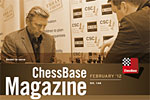


ChessBase 17 - Mega package - Edition 2024
It is the program of choice for anyone who loves the game and wants to know more about it. Start your personal success story with ChessBase and enjoy the game even more.
 ChessBase Magazine 146
ChessBase Magazine 146ChessBase Magazine #146 (DVD), Rainer Knaak (ed), ChessBase, $23.95 (ChessCafe Price: $19.95)
Reviewing the latest ChessBase Magazine was an eye-popping experience for someone like myself who has not seen a recent issue. (I had a subscription when it used to be distributed on CD.) It comes with a twenty-six page booklet in English and German. The enlarged format, compared to earlier issues, is a wholesale improvement. It provides an absolutely wonderful summary of the material on the DVD! The disk also contains a PDF file of the booklet, along with a PDF index of the opening surveys from previous issues.
The material is divided as follows:
On the very first page, accompanying the editorial, is an invitation to take part in a reader survey to make the magazine even more relevant, with prizes given to selected participants. Both Carlsen and Nakamura annotate the game Carlsen-Nakamura from London. Nakamura also annotates his save against Anand. Nigel Short provides an excellent audio analysis of his King's Gambit game against McShane, in which he explains, "under what conditions you can play this 'lousy opening' and why the King's Gambit is OK anyway." All the audio commentaries were top-notch, and, for me, the audio analysis is often superior to the video portions, since I get distracted from the chess content by watching the presenter in the video segments.
All 684 games from the European Championship are included, with an extra bonus being Marin's bringing together of all the theoretically important games in a fascinating analysis. Peter Wells' article on prophylaxis was very useful to me. Not only does the article show how to implement this concept, but the accompanying discussion of ChessBase 11 shows how to access further games from the database with prophylaxis as the theme!
I found Wells' essay extremely thought-provoking and one I will ruminate over for some time to come. Moreover, he put me at ease about my self-assessed lack of understanding on the topic when stating, "For over the years, I have gradually formed the impression that the term 'prophylaxis' is more frequently used and even revered, than it is entirely comprehended." He is willing to show his own deficits in the area and includes a discussion of the "human component" of prophylactic moves (the annotations on the DVD are much deeper than I give here):

White played the mysterious rook move 18.Rab1!!, with Wells noting he found the move "genuinely profound" once explained to him, and "baffling" beforehand:
"To find this move White not only needs to appreciate the importance of keeping an eye on Black's d5 pawn break, he needs to realise that its immediate implementation 18...d5?! Is rendered problematic by the reply 18.Bxf8 Kxf8 20.b4! When neither the bishop on b7 nor Black's dark squares have reason to be happy with the turn of events. For this reason Dolmatov regarded the preliminary exchange 18...bxa4 19.bxa4 d5 as the real problem, and it is that against which his move is primarily directed."
Wells presents many examples of masters with great prophylactic ability and stresses that those who are good at prophylaxis are not only great strategic players, but also possess great tactical ability, which they use to prevent tactics being employed against them. As Robert Byrne once noted of Petrosian, he trades off your attacking pieces before you even realize you have an attack. He also declares Dvoretsky as probably the one author who has tackled the topic in any serious way. This is an essay I plan to read several times during the coming months.
I also really enjoyed Rainer Knaak's opening trap, one reason being that it meshes well with Grivas' own discussion of the Grivas Sicilian. The trap involves the move ...Qxb2, taking a "poisoned pawn" – for some time now I have been collecting examples of the ...Qxb2 move, wondering when Black can and cannot take the pawn. It shows what happens if a player sticks too closely to the plan: 1.e4 c5 2.Nf3 Nc6 3.d4 cxd 4.Nxd4 Qb6 is the normal Grivas, but what happens on 4.Nc3 Nf6 4.d4 cxd 5.Nxd4? Should Black still try 5...Qb6? No! In this case 6.Be3! is nearly crushing. I'll let you buy the magazine to find out how.
As to the trainers, Lilov's "model game" made me feel confident I could handle the London System with success; the presentation is idea-based and he notes that the ideas will work even if White does not follow a specific move-order. It's simple really, at least the way he presents it: play for central breaks and realize that a well-timed ...Nh5! often ruins White's game. Lilov always seems to impart concepts in a crystal-clear manner than inspires confidence. I can't wait to face the London!
There is just so much interesting material in ChessBase Magazine that I can't imagine a better chess bargain than this product.
My assessment of this product: Excellent (six out of six stars)